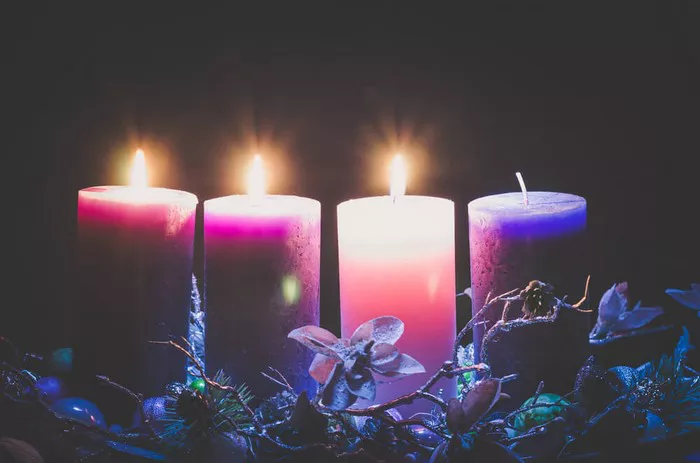Advent is a special time of the year for Christians, as it marks the beginning of the liturgical calendar and the anticipation of the celebration of Jesus Christ’s birth. One of the most recognized symbols of Advent is the Advent wreath, a circular arrangement of evergreens with four candles. These candles are lit progressively over the four Sundays of Advent, leading up to Christmas. Of the four candles, three are typically purple, and one is pink. But what do these purple Advent candles represent? Let’s explore their deeper meanings, their significance in the Advent season, and how they connect to Christian faith and tradition.
The Tradition of Advent and the Advent Wreath
Before diving into the meaning of the purple Advent candles, it’s essential to understand the history and tradition behind Advent itself.
Advent is a time of preparation and anticipation, beginning on the Sunday closest to November 30 (the Feast of St. Andrew) and lasting until Christmas Eve. The word “Advent” comes from the Latin word adventus, which means “coming.” This period represents the waiting for the arrival of Jesus Christ, both in terms of his first coming in Bethlehem and his second coming at the end of time.
The Advent wreath originated in Germany in the 16th century and was later adopted by Christians around the world. It is typically made of a circle of evergreen branches to symbolize eternity, with four candles placed within it. Traditionally, the wreath is placed on a table, with one candle being lit each Sunday during Advent. The candles represent the passage of time as believers prepare their hearts for Christ’s birth.
The Purple Advent Candles: Meaning and Symbolism
Out of the four candles on the Advent wreath, three are purple, and one is pink. Each of the purple candles carries its own special significance, linked to the themes of hope, peace, joy, and love—key elements of the Advent season. Let’s break down the meaning of these purple candles.
1. The First Purple Candle: The Candle of Hope
The first purple candle is known as the Candle of Hope or the Prophecy Candle. It is lit on the first Sunday of Advent. The color purple is traditionally associated with royalty, penance, and preparation, which is why it is used throughout Advent. The first candle represents the hope of Christ’s coming and the promise of salvation that the Old Testament prophets foretold.
In the Bible, many prophecies speak of a coming Messiah who will bring salvation to God’s people. This first purple candle symbolizes the hope that believers have in Jesus Christ, who was promised as the Savior. Lighting this candle is an act of remembering the hope of the Israelites, who waited for the fulfillment of God’s promises, and the hope of modern Christians, who await Christ’s return.
This candle also represents the anticipation of Christ’s coming into the world. The reading for this week often focuses on the prophecies of the Messiah, as found in the Old Testament. It emphasizes the hope that the birth of Jesus brings to the world—a hope for redemption, peace, and healing.
2. The Second Purple Candle: The Candle of Peace
The second purple candle is called the Candle of Peace or the Bethlehem Candle. This candle is lit on the second Sunday of Advent. The theme for this week revolves around peace, and the second candle signifies the peace that Jesus will bring to the world.
When Jesus was born in Bethlehem, the angels declared, “Glory to God in the highest heaven, and on earth peace to those on whom his favor rests” (Luke 2:14). This peace is not just an absence of conflict, but a deeper, spiritual peace that transcends circumstances. It is the peace of reconciliation with God, which Jesus made possible through his life, death, and resurrection.
The second purple candle also reminds believers of the peace that Jesus offers to those who accept him. It invites Christians to reflect on their own need for peace—peace in their hearts, in their homes, and in the world. This peace is a gift of Christ’s presence, and it is the fruit of the hope that the first candle symbolizes.
3. The Third Purple Candle: The Candle of Love
The third purple candle is often called the Candle of Love or the Shepherd’s Candle. However, it is more commonly referred to as the Candle of Joy in many Advent wreath traditions. While this candle is purple in color, it symbolizes joy and love, which are two key themes that emerge as Advent progresses.
The third Sunday of Advent is known as Gaudete Sunday, from the Latin word gaudete, meaning “rejoice.” On this Sunday, the Church encourages a shift in the mood of Advent from a somber, penitential tone to one of joyful expectation. For this reason, the candle for this week is sometimes pink (or rose-colored) to symbolize the joyful nature of the coming Christmas celebration.
However, the purple candle still carries the themes of love and joy. This candle is a reminder of the love that God has for the world, as shown through the gift of Jesus Christ. It also points to the joy that Christians experience in knowing that Jesus is coming to bring salvation. Jesus’ birth brings love to the world in a way that no other event could—God’s love made manifest in human form.
This candle also encourages Christians to reflect on their own relationships with others. The love that Jesus brings is meant to be shared. It is a love that calls for compassion, mercy, and care for those around us.
4. The Fourth Purple Candle: The Candle of Joy (or Peace)
The fourth purple candle, which is lit on the fourth Sunday of Advent, also has a deep significance in the journey to Christ’s birth. This candle is sometimes called the Candle of Peace, as it brings the final reflection on the peace that Jesus offers. In some traditions, this candle is known as the Candle of the Angels, because it signifies the joy the angels expressed when they proclaimed Christ’s birth to the shepherds.
This final purple candle represents the joy of the coming of Christ. It celebrates the nearness of Christmas and the fulfillment of God’s promises. With just a few days left before Christmas, believers are reminded to rejoice in the coming of the Savior and to share that joy with others. It is also a time to reflect on the joyful hope and peace that the previous candles have brought and to prepare for the grand celebration of Christ’s birth.
The Role of the Purple Candles in Advent
Throughout the Advent season, the purple candles help Christians reflect on the key themes of preparation, penitence, and waiting. These purple candles are a visual reminder that Advent is not just a time of celebration but also a time of reflection. They remind Christians to prepare their hearts for the coming of Christ and to reflect on the virtues that he embodies: hope, peace, love, and joy.
The purple color itself is a liturgical color that symbolizes penitence, humility, and preparation. Traditionally, purple is used during Advent and Lent, two seasons of the Church calendar that focus on anticipation and repentance. Advent, with its focus on the coming of the Messiah, calls for a spirit of quiet reflection and readiness, and the purple candles underscore this attitude.
Conclusion
The purple Advent candles represent more than just a countdown to Christmas. They are rich in meaning and symbolism, guiding Christians through a journey of preparation, reflection, and spiritual growth. Each purple candle—hope, peace, and love—reminds believers of the promises of God and the coming of Christ into the world. As Christians light each candle, they are invited to reflect on their own hearts and lives, preparing themselves for the joy and celebration of Christmas. The purple Advent candles, in all their simplicity, point to the deeper significance of the Advent season, reminding us to wait with hope, peace, love, and joy for the arrival of the Savior.
Related topics:



























